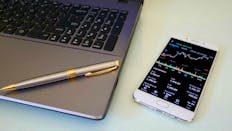OANDA Review (2026)
All products and services featured are independently selected by WikiJob. When you register or purchase through links on this page, we may earn a commission.
What Is OANDA?
OANDA was first established in 1997 as a provider of free currency exchange over the internet.
In 2018, it became a multi-asset broker, offering several trading instruments with a focus on forex.
Based in Delaware, OANDA has been involved in some big innovations throughout its history, thanks to the specialisms of the co-founders Dr Michael Sturn (computer engineer) and Dr Richard Olsen (economics expert).
Perhaps the most well-known was the development of one of the first Wireless Application Protocols (WAPs) in collaboration with NOKIA in 1999.
OANDA launched its trading platform in 2001, which is now a multi-award-winning service, offering traders a smooth, personalized experience.
Pros
- Regulated by the NFA and FCA
- Accepts US clients
- User-friendly
- Good customer service
- No minimum deposit
Cons
- No account protection for UK and US accounts
- Limited social trading tools
- Ancillary fees
Is OANDA Regulated?
As OANDA is based in the US, it is fully regulated by the NFA and CTFC, as well as in several other jurisdictions.
The full list of regulatory bodies is:
- CFTC
- NFA
- FCA
- IIROC
- ASIC
- MAS
- JFSA
Is OANDA Safe to Use?
Although there are inherent financial risks involved in any type of trading, looking for a safe broker is important.
OANDA is well-regulated in several worldwide jurisdictions, especially in the US, Europe and Australia. Although OANDA is not publicly traded, it does publish its annual financial statements. OANDA does not operate a bank.
In terms of safety for portfolios, OANDA offers negative balance protection for EU retail clients, but there is no such protection available for professional or non-EU clients.
Who Is OANDA For?
OANDA is mostly aimed at experienced traders, and although there is a good offering of educational materials – even those aimed at complete beginners – many users feel that it is primarily aimed at those with prior knowledge.
This is backed by the premium account on offer that requires a large balance and trading volume in the millions.
The general trading experience is good – users consider it a reliable broker with good customer service, although it might be considered a bit basic in terms of the variety of offerings.
OANDA Products and Services
Although there is a degree of variety to the products available to trade on OANDA, the main focus is forex.
There is enough variety to make OANDA a multi-asset trading platform, but nowhere near the amount offered by other brokers.
The markets also vary depending on location, so some instruments might not be available in every country.
For example, you cannot trade CFDs in the US, and you cannot trade crypto CFDs in the UK.
The trading instruments available on OANDA are:
- 55 CFDs
- 70 currency pairs
- 7 indices
- 8 commodities
- 5 metals
- 6 bonds
Aside from the trading pairs, OANDA has an exchange-rates API that is used and trusted by thousands of global companies, and a historical currency converter that provides 25 years of rates across 38,000 currency pairs.
OANDA Platform Features and Tools
Desktop
The desktop trading experience was first released as fxTrade in 2001 and is now known as OANDA Trade.
Users can download free software that allows them to trade directly from charts.
There are more than 10 chart types, from basic to the more complicated Renki and Kagi.
Users can choose personalized layouts from 10 different types, and can operate multiple trade profiles with separate trade defaults.
Through the desktop platform, you can receive up-to-date market news from third-party services like Dow Jones International and 4CAST, as well as the research completed by the OANDA team in the MarketPulse report.
The OANDA Trade desktop platform is user-friendly, but the downside is the lack of notifications.
Web
The web version of OANDA Trade has an intuitive interface, and thanks to the connectivity, users can experience faster trading times.
The innovative trading tools offered by OANDA Trade are based on the idea of advanced technical analysis, such as order book overlay, position ratios and a news aggregator.
The analysis is an unbiased provision based on the statistics from the last six months.
Through the web platform, users can create their own algorithmic trading through Algo Labs (powered by Quant Connect). There is also a full suite of risk-management tools such as stop-loss orders.
The most important features of the OANDA Trade platform – both on the desktop and web versions – are the clear portfolio and fee reports.
Mobile
OANDA Trade is available as a native app for Android and iOS, with access to the full range of currency pairs.
The app is designed for full usability, with a customizable interface and notifications – you can choose the amount and types of alerts that you receive.
You can react to changes in real time, and even add funds directly from your device in some cases. The app is very user-friendly, with a two-step login process (although not biometric).
The functionality of the app may not be as deep as the web or desktop platform, but users can access performance analytics and mobile charting.
MetaTrader 4
The MetaTrader 4 (MT4) platform is popular amongst traders, and you can access MT4 through a custom-built bridge with your OANDA account. This allows you to combine OANDA pricing and execution with MT4’s charting and analysis.
There is a premium upgrade available on MT4 that allows for algorithmic trading, additional indicators and expert advisors, and you can also add a suite of OANDA technical analysis tools as a plug-in to the MT4 platform.
TradingView
OANDA has partnered with the well-known platform TradingView, which offers industry-leading charts, community features and analytical tools.
When these features are added to the transparent pricing, fully automated risk management and market data of OANDA, traders have all the tools they need to build a well-informed portfolio.

OANDA Account Types
There are two account types available to OANDA users – Standard and Advanced Trader.
Standard
The Standard account offers both a demo and live version, with access to all trading instruments. There is no minimum account balance needed, and you can get access to all platforms through the Standard account.
Through the Standard account, you can choose between spread-only pricing, or core pricing and commission.
You can have multiple sub-accounts to support trading in different currencies or for using different trading rules and tools.
Advanced Trader
This is a loyalty program that users can sign up for. It includes all the features of the Standard account, plus some extras.
Depending on your monthly trading volume, you can receive cash rebates and reduced trading costs.
Advanced Traders are also given a dedicated relationship manager and faster access to support.
The financial benefits of the Advanced Trader platform are not only reduced commission and cash rebates but also faster fund processing, free wire transfers and a discount for third-party platform access.
OANDA Commissions and Fees
In comparison to other brokers, OANDA has relatively low commission, priding itself on being completely open and transparent in terms of costs.
There are two pricing options, so users can choose how they want to pay commission:
-
Spread-only – The cost of trading is built into the spread and there is no other commission to pay. As an example, the spread on EUR/USD for spread-only pricing is 1.4 pips.
-
Core pricing and commission – This is a fee that is fixed, based on a core price of $5 per 100,000 units as well as a significantly lower spread price – in the EUR/USD example, the spread price would be 0.4 pips.
OANDA sources pricing from a global network of premier banks and does not requote from the time of the trade.
There are no charges for account opening or deposit. There is a basic inactivity fee that kicks in after 12 months of no use – just $10 (or 10 of your base currency) per month.
Where OANDA is perhaps more expensive than other brokers is in withdrawal fees.
The withdrawal options are wide-ranging, but there are charges for certain types. OANDA charges differently for the first withdrawal in a month compared with subsequent times:
- Debit card – Withdrawals are completely free
- Credit card – First in month is free, $15 each thereafter
- Bank transfer – First in month $25, subsequent $35
- PayPal – Completely free
Withdrawals typically take around 24 hours.
OANDA Research and Education
OANDA offers lots of research, both from in-house and third-party sources. Some of the research available includes:
- Economic analysis
- Real-time news feeds
- Calendars
- Advanced data analytics
- MarketPulse – a news stream written by OANDA’s research team
- Dow Jones and 4CAST
There are also a lot of educational resources available, although some users find that the materials are not very straightforward to use.
The demo account is a great way to learn by doing if that is your style, but there are other resources available:
- Webinars – both live and recorded
- Tutorial videos
- Blogs and articles
Pros of OANDA
-
Regulated by the NFA and FCA – The NFA and the FCA are widely considered two of the most reliable regulatory bodies, so regulation by them inspires trust.
-
Accepts US clients – There are several well-respected brokers who are not regulated in the US, so OANDA offers a way for American traders to have access to forex in particular.
-
User-friendly – One of the most repeated lines in any review of OANDA and its product is how user-friendly its offering is. This is thanks to well-designed interfaces and the ability to truly personalize all areas of the platform – from charts to notifications.
-
Impressive analysis tools – OANDA knows the market, and there are so many advanced data-analysis tools available that users can trade and invest in the way that best suits them. Charting, order types and other analysis is available for all account holders.
-
Good research and educational resources – For a trading platform that is aimed at the more experienced trader, it does provide a huge range of educational resources suitable for beginners and intermediate traders. Some of the resources are available to non-account holders, while more premium content like the live webinars is only available to account holders. Research is similarly broad, from all areas of the market.
-
Good customer service – Customer service is important, and OANDA offers 24/5 contact options. While not available over the weekend, users feel well supported and those that hold an Advanced Trader account get faster support.
-
Demo account – Unlike some platforms that offer a demo account for a limited period, the OANDA demo account remains available to users whenever they need it. This allows even experienced traders to practice new techniques without risking live funds.
-
No minimum deposit – Not asking for a minimum deposit is one of the biggest differences between OANDA and other brokers, although this only applies to Standard accounts.
Cons of OANDA
-
No account protection for UK and US accounts – Despite being regulated in many jurisdictions, there is no additional account protection available for US and UK accounts, unlike for EU accounts which have negative balance protection.
-
Limited social trading tools – Some trading tools are noticeably absent from the OANDA platform; for example, social and copy trading functionality.
-
Ancillary fees – While OANDA has low trading fees, the withdrawal fees could be a problem for some traders, especially those who are using credit cards or a bank account to fund and withdraw.
-
Limited portfolio – One of the biggest problems that users face with OANDA is the limited trading instruments. Although it does offer CFDs, there are no individual stocks or ETFs. In some jurisdictions, you can trade cryptocurrency CFDs, but users cannot buy or sell cryptocurrency itself.
-
No tax accounting tools – Despite the need for correct accounting of portfolio funds for tax reasons, OANDA does not have any specific tax accounting tools available.
-
Phone and live-chat customer support is limited to working hours – OANDA follows the usual market trading hours, as does the phone and live-chat customer support. Users who need help over the weekend or when the markets are closed must wait until Monday to speak to someone.
How to Set Up an OANDA Account
Setting up an OANDA account is simple and fully digital, and in most cases takes less than 10 minutes. The account needs to be authorized, which usually takes less than 24 hours.
- Select ‘Start trading’, confirm your location and choose a username and password
- Add personal and financial details as requested
- Complete the knowledge test to assess your trading experience
- Verify your identity and residency – upload documents or send via email
- Account is verified and ready to use – no minimum deposit required
The verification documents needed are pretty standard. To confirm identity, you need your driver’s license, passport or some form of national ID. For proof of residency, use a utility bill or bank statement.
Final Thoughts
Experienced traders find that OANDA offers a streamlined interface and extensive trading analytics, but the expensive withdrawal fees in comparison to other brokers might be off-putting to new users.
OANDA has a great track record of being at the forefront of technology in forex, so it is extremely focused on providing currency-related content and innovation – although this does mean there is perhaps less focus on other trading instruments.
If you are looking for a broad portfolio that includes EFTs and individual stocks, OANDA might not be suitable for you.
OANDA is a client-focused, multi-asset broker that offers a great proprietary trading platform and low trading costs. When these are combined with extensive research, education and advanced analytical tools, experienced traders will feel supported in their quest for success in trading forex and CFDs.
WikiJob does not provide tax, investment, or financial services and advice. The information is being presented without consideration of the investment objectives, risk tolerance, or financial circumstances of any specific investor and might not be suitable for all investors. Past performance is not indicative of future results. Investing involves risk including the possible loss of principal.





